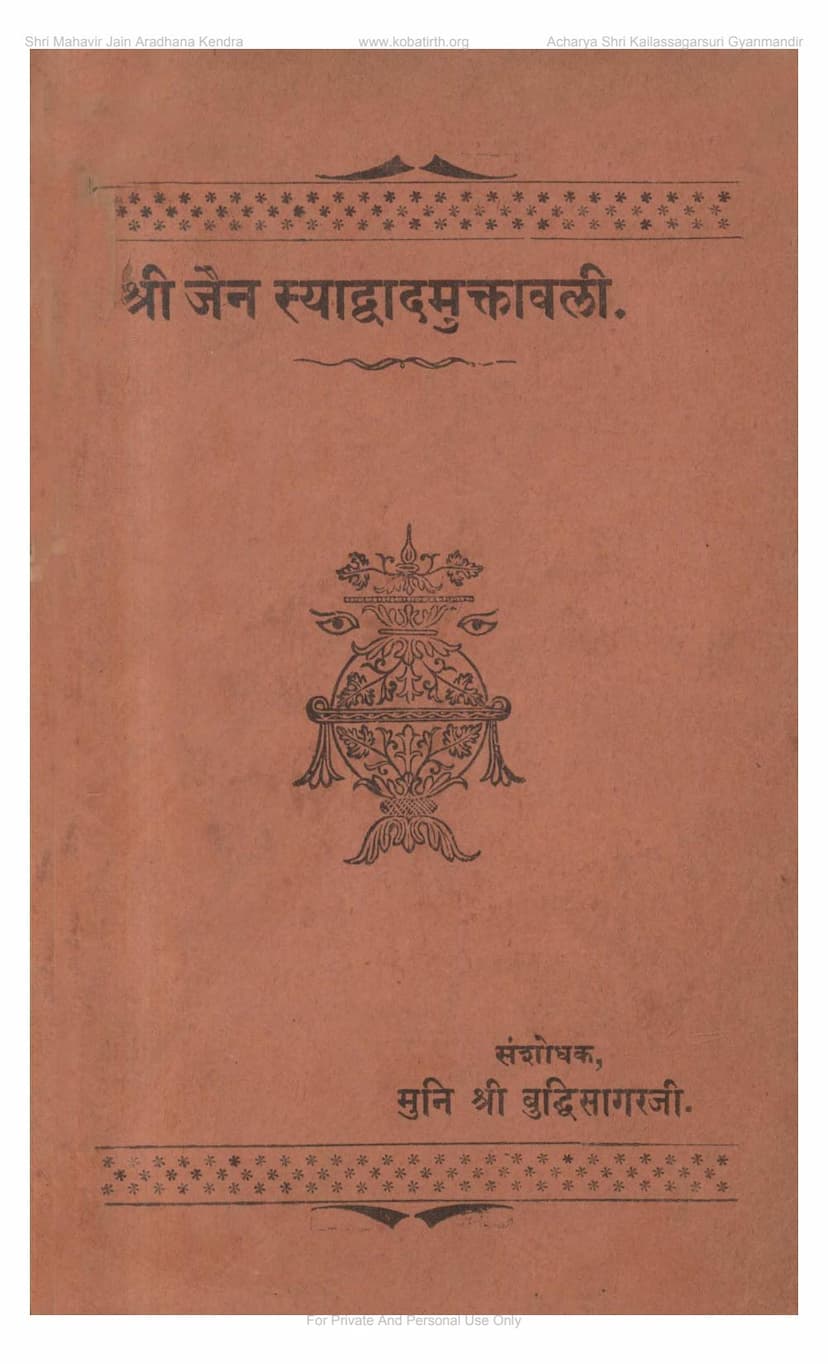Jain Syadvadamuktawali
Added to library: September 2, 2025

Summary
Here's a comprehensive summary of the Jain text "Jain Syadvadamuktawali" by Muni Shri Buddhisagar, based on the provided pages:
Book Title: Jain Syadvadamuktawali (श्री जैन स्याद्वादमुक्तावली) Author: Muni Shri Buddhisagar (संशोधक, मुनि श्री बुद्धिसागरजी) Original Author: Pandit Muni Shri Yashasvatsagar Gani (पंडित यशस्वत्सागरगाण कृत) Publisher: Vadilal Vakhatchand Zaveri (छपावी प्रसिद्ध करनार, झवेरी वाडीलाल वखतचंद) Location: Ahmedabad (अहमदाबाद) Year: Vir Samvat 2435, Samvat 1965
Overall Purpose and Introduction:
The preface (Page 4) highlights that Jain philosophy aims to lead humans to the nature of the soul, which is divine. While many Jain philosophical texts exist, some are very profound and difficult for ordinary individuals to grasp. To make the complex principles of Jain logic accessible, especially to beginners, this book, "Jain Syadvadamuktawali," was created.
The current edition was undertaken by Pandit Muni Shri Buddhisagar, who found a manuscript and realized its value for disseminating Jain logic. He approached Shri Bhogilal Mangalbhai Tarachand of Ahmedabad, who generously agreed to publish it. Muni Buddhisagar also mentions that the original author, Pandit Muni Shri Yashasvatsagar Gani, was a highly learned scholar in logic and poetry.
Author of the Original Work:
The original author is identified as Pandit Muni Shri Yashasvatsagar Gani of the Tapagachha tradition. While his exact life history and geographical movements are not definitively known, it's estimated he was active around Samvat 1720 (approximately 1663 CE). He belonged to a lineage of scholars within the Tapagachha, tracing back to Acharya Shri Vijayaprabhasurishwar. The preface notes his significant scholarship in logic and poetry and expresses hope that someone might write a commentary on this work.
Key Philosophical Concepts Discussed:
The book, as indicated by its title and content, focuses on Syadvada (the doctrine of conditioned predication) and the principles of Jain logic (Nyaya). It aims to explain these concepts in a simple and accessible manner.
Structure and Content (Based on the provided pages):
The text is divided into "Stabakas" (sections or chapters), with the following being discernible from the provided pages:
- Pratyaksha Pramana (Direct Perception): The first section (Pages 6-21) deals with the nature of direct perception in Jainism. It discusses how knowledge is acquired, the categories of knowledge, and the characteristics of valid direct perception.
- Paroksha Pramana (Indirect Perception): The second section (Pages 21-31) explains indirect knowledge. It details the different types of indirect knowledge such as remembrance, recognition, inference (tarka, anumiti), and scripture (shruta). The importance of inference based on cause and effect, concomitance (vyapti), and logical reasoning is elaborated.
- Prameya Sadabhasapranam (Fallacies of Objects of Knowledge): The third section (Pages 31-36) seems to discuss the fallacies or incorrect apprehensions related to the objects of knowledge. It appears to analyze how misconceptions can arise in understanding reality and its various aspects.
- Naya Swaroopa Prarpanam (Explanation of the Nature of Nayas): The fourth section (Pages 36-43) delves into the concept of Nayas (standpoints or perspectives) in Jain logic. It explains that Nayas are crucial for understanding the multifaceted nature of reality. The text outlines the seven Nayas:
- Dravyarhtika Naya (Substance-oriented viewpoint):
- Naigama Naya (Conventional/General viewpoint)
- Sangraha Naya (Collection/Universal viewpoint)
- Vyavahara Naya (Practical/Conventional viewpoint)
- Paryayarhtika Naya (Attribute-oriented viewpoint):
- Rjusutra Naya (Simple/Sequential viewpoint)
- Shabda Naya (Verbal viewpoint)
- Samabhirudha Naya (Meaning-oriented viewpoint)
- Evambhuta Naya (Actualized viewpoint)
- Dravyarhtika Naya (Substance-oriented viewpoint):
The text emphasizes that these Nayas, when understood correctly, do not contradict each other but rather highlight different facets of reality. It also warns against "Nayaabhasas" (fallacious standpoints) that distort the truth by focusing on only one aspect and ignoring others.
Key Principles of Syadvada:
While not explicitly detailed in the introductory pages, the title and the overall context of Jain logic imply that Syadvada, the doctrine of conditional statements (using "Syad" - perhaps/maybe), is central. Syadvada posits that all statements about reality are relative and depend on the particular perspective or standpoint. This is crucial for understanding the anekanta (non-one-sidedness) nature of Jain philosophy. The text likely uses the Seven-Fold Syadvada (Saptabhangi) to illustrate how an object can be described from multiple, seemingly contradictory, standpoints.
Key Terms and Concepts:
- Anekanta (Non-one-sidedness): The fundamental Jain principle that reality has infinite aspects, and no single viewpoint can capture its entirety.
- Pramana (Valid Knowledge): The means of acquiring true knowledge. The text discusses Pratyaksha (direct) and Paroksha (indirect) as the two main types of Pramanas.
- Naya (Standpoint/Perspective): Different ways of looking at an object, each highlighting a particular aspect.
- Dravya (Substance): The underlying reality that persists through change.
- Paryaya (Attribute/Mode): The changing states or characteristics of a substance.
- Saptabhangi (Seven-Fold Predication): The logical framework of Syadvada, involving seven possible predications about an object (is, is not, is and is not, is indescribable, is and is indescribable, is not and is indescribable, is and is not and is indescribable).
Overall Significance:
"Jain Syadvadamuktawali" serves as an introductory text to the complex philosophical and logical systems of Jainism, particularly Syadvada and Naya. It aims to make these profound teachings accessible to a wider audience, especially those new to Jain philosophy. The efforts of Muni Shri Buddhisagar in revising and publishing this work are highlighted as a valuable contribution to Jain education.